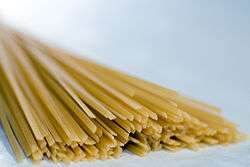Linguine
Linguine (/lɪŋˈɡwiːni/; Italian: [liŋˈɡwiːne]) is a type of pasta similar to fettuccine and trenette but elliptical in section rather than flat. It is about 4 millimetres (0.16 in) in width, which is wider than spaghetti but not as wide as fettuccine.[1][2] The name linguine means "little tongues" in Italian, where it is a plural of the feminine linguina.[3] A thinner version of linguine is called linguettine.[4] Linguine was traditionally served with sauces such as pesto but others such as tomato or fish based sauces are popular as well.[5] Linguine is typically available in both white flour and whole-wheat versions but was originally made with durum wheat.[6] Linguine originated in Italy and is based on more traditional pastas.[7]
 | |
| Type | Pasta |
|---|---|
| Course | Primo |
| Place of origin | Italy |
| Region or state | Liguria |
| Main ingredients | Flour and egg |
| Variations | Linguettine |
| Depends on serving kcal | |
See also
- List of pasta types
- Trenette
References
| Wikimedia Commons has media related to Linguine. |
- "Fresh Pasta widths and serving sizes Lasagne sheets and Asian Noodles". www.cucinafoods.co.nz. Retrieved 2020-02-11.
- "CNN Food Central - Resources: Pasta Shapes and Sizes". www.cnn.com. Retrieved 2020-02-11.
- "Definition of LINGUINE". www.merriam-webster.com. Retrieved 2020-02-11.
- "Linguine & Linguettine". www.ultimatecookingguide.com. Retrieved 2020-02-11.
- "Linguine". Pasta Fits. 2018-08-24. Retrieved 2020-02-11.
- "The Difference Between Linguine, Spaghetti and Fettuccine". Pastamania. 2019-06-01. Retrieved 2020-02-11.
- "About Linguine". ifood.tv. Retrieved 2020-02-11.
This article is issued from Wikipedia. The text is licensed under Creative Commons - Attribution - Sharealike. Additional terms may apply for the media files.